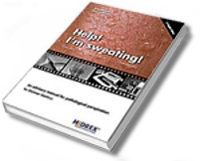best practical book on hyperhidrosis
by Dietmar Stattkus (comments: 0)

I suffered from severe palmar hyperhidrosis since early puberty, and had the endoscopic thoracic sympathectomy (ETS) surgery in 1998 to cure the condition after various creams and solutions did nothing to help me. Although the surgery was a success, my plantar (feet) hyperhidrosis severely worsened as a side effect and now I am unable to wear footwear without wearing socks too, and am unable to walk bare feet much of the time without having things stick to my feet. I started my own hyperhidrosis related website and forum in 2005 to help myself as well as others. On the website, I recommend alternatives to ETS surgery first.
Despite knowing quite a lot about hyperhidrosis and having my own informative website, reading Dietmar Stattkus's book left me feeling that my knowledge about the subject was definitely lacking in many areas. I wish that I had read this book before I had my surgery.
-- The chapter on drug-based therapies is especially insightful. I was not aware of so many options and products out there when you include "ingestion of tablets or application of ointments, emulsions, powders or creams." The chapter makes many fine points, such as the difference between aluminum chloride hexahydrate (AICI3) and the less effective aluminum hydroxychloride, plant-based versus synthetic tannins, natural treatments such as sage (and the Sweatosan brand of sage-based tablets), mechanisms on how anticholinergics work (via the interplay of sweat glands, cholinergic nerves, sympathetic nerve fibers and the hypothalamus), listing of drugs that are sold in Europe and that might not be commonly known in the US (e.g., Sormodren, Vagantin) and much more.
-- A unique aspect of the book is that it also covers social phobia, depression, bromhidrosis (smelly sweating), psychosocial conflicts and other conditions that can be related to hyperhidrosis. I do not suffer from such problems for the most part, so I did not go through these sections in detail.
-- A listing of products at the end of the book is very useful and covers over 50 items under categories such as herbal antihidrotics, anticholinergics, receptor blockers, astringents and antihidrotics, antiperspirants, psychopharmaceuticals and so on. I didn't know that besides Botox, there is another botulinum toxin product called Dysport.
-- The book also includes some great pictures, detailed first-person reports on ETS as well as reports on unique surgeries (e.g., Dr Popp's presentation on the latest aspiration hidrectomy procedure, a kind of liposuction of armpit sweat glands).
The one negative thing I found in the book was that the iontophoresis section only covered the Hidrex machine, and left out other popular options such as Drionic, Idrostar and Fischer MD-1a. Also, the Botox section on hyperhidrosis did not cover Botox injections in the hands and feet, which have recently become popular in the US. The book focused on Botox injections in the armpits, which are very popular and highly effective.
All in all, if you were to buy one book on hyperhidrosis, I would recommend this one. This book was originally written in German, but is far more useful than any other English hyperhidrosis book or website that I have ever browsed.
